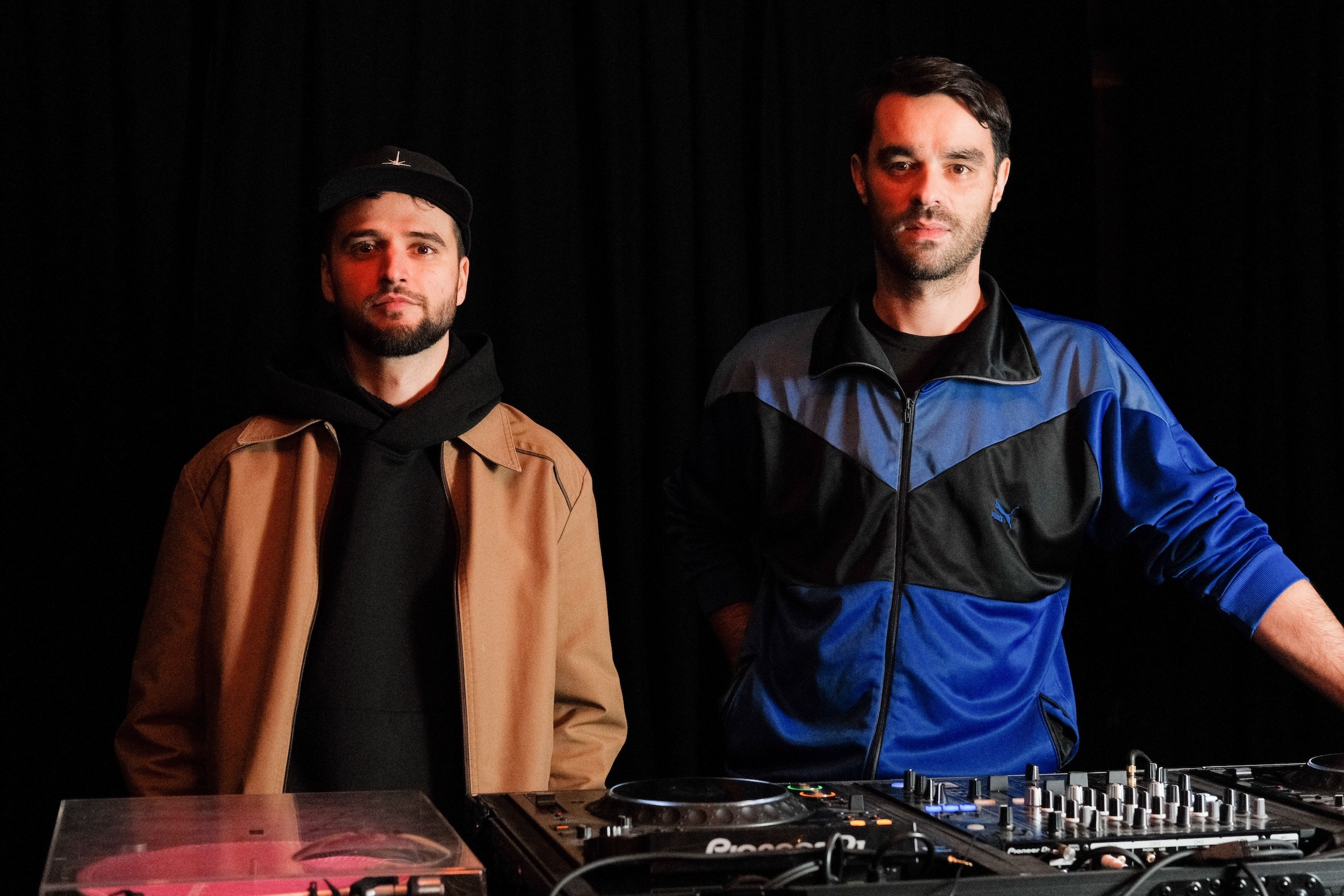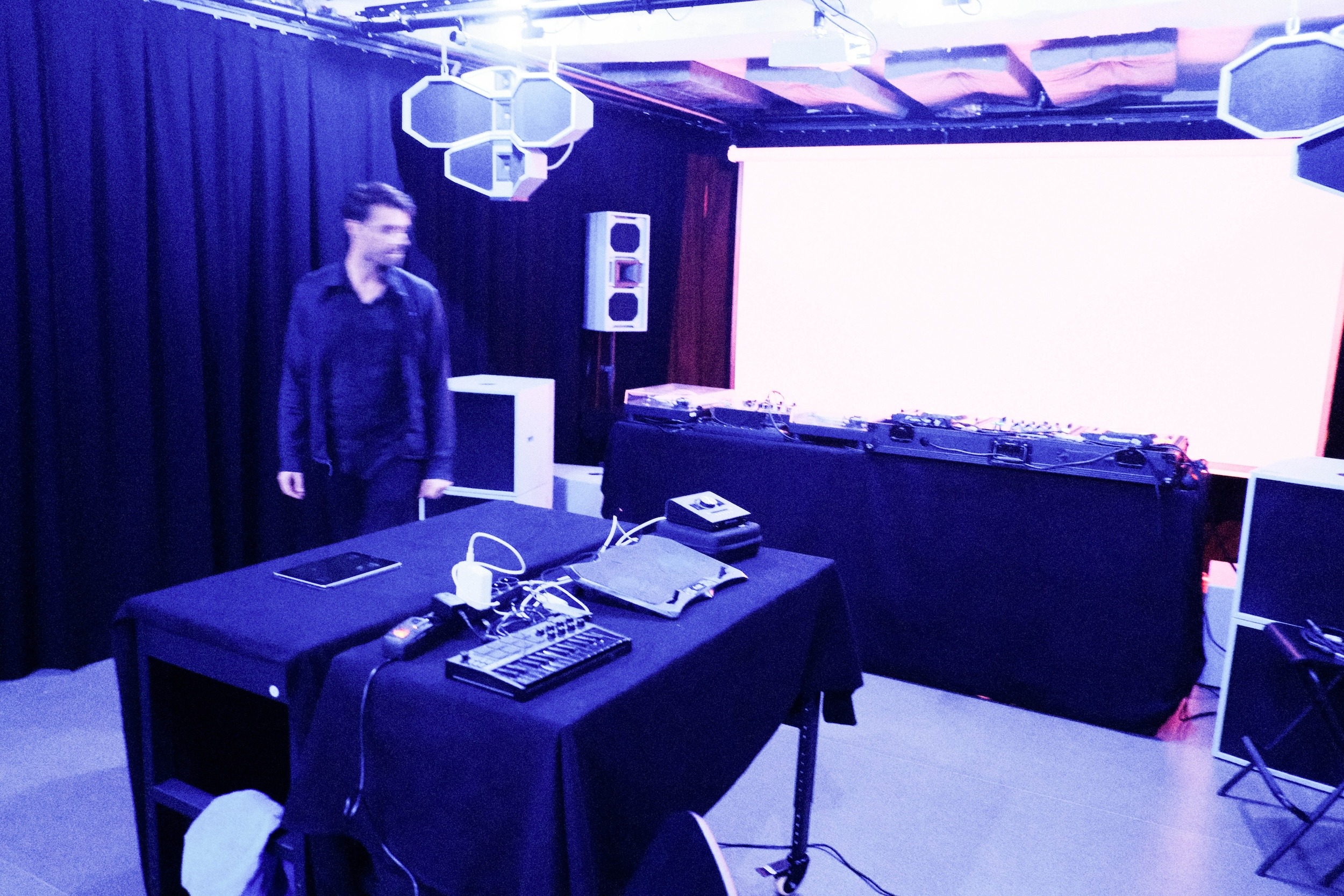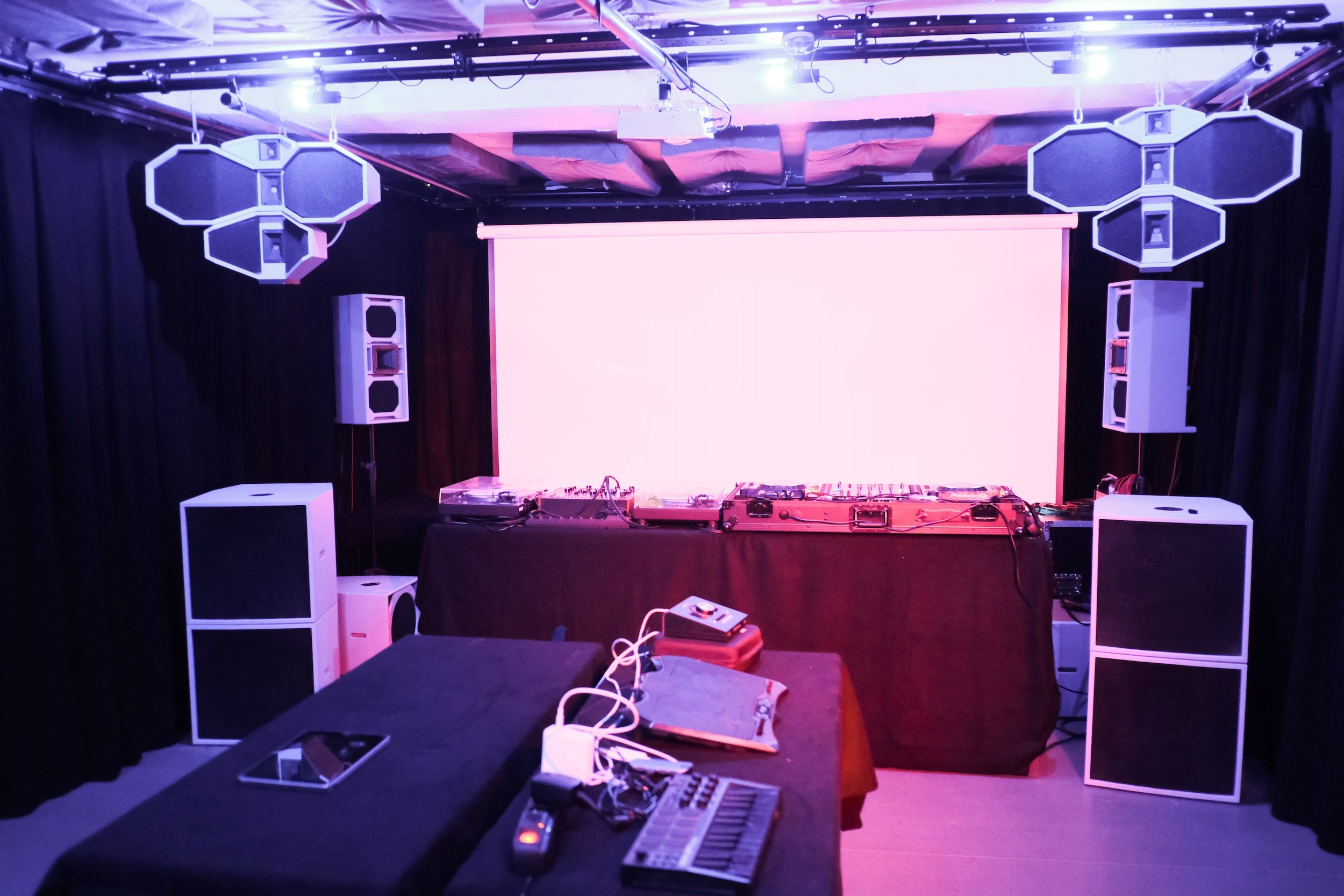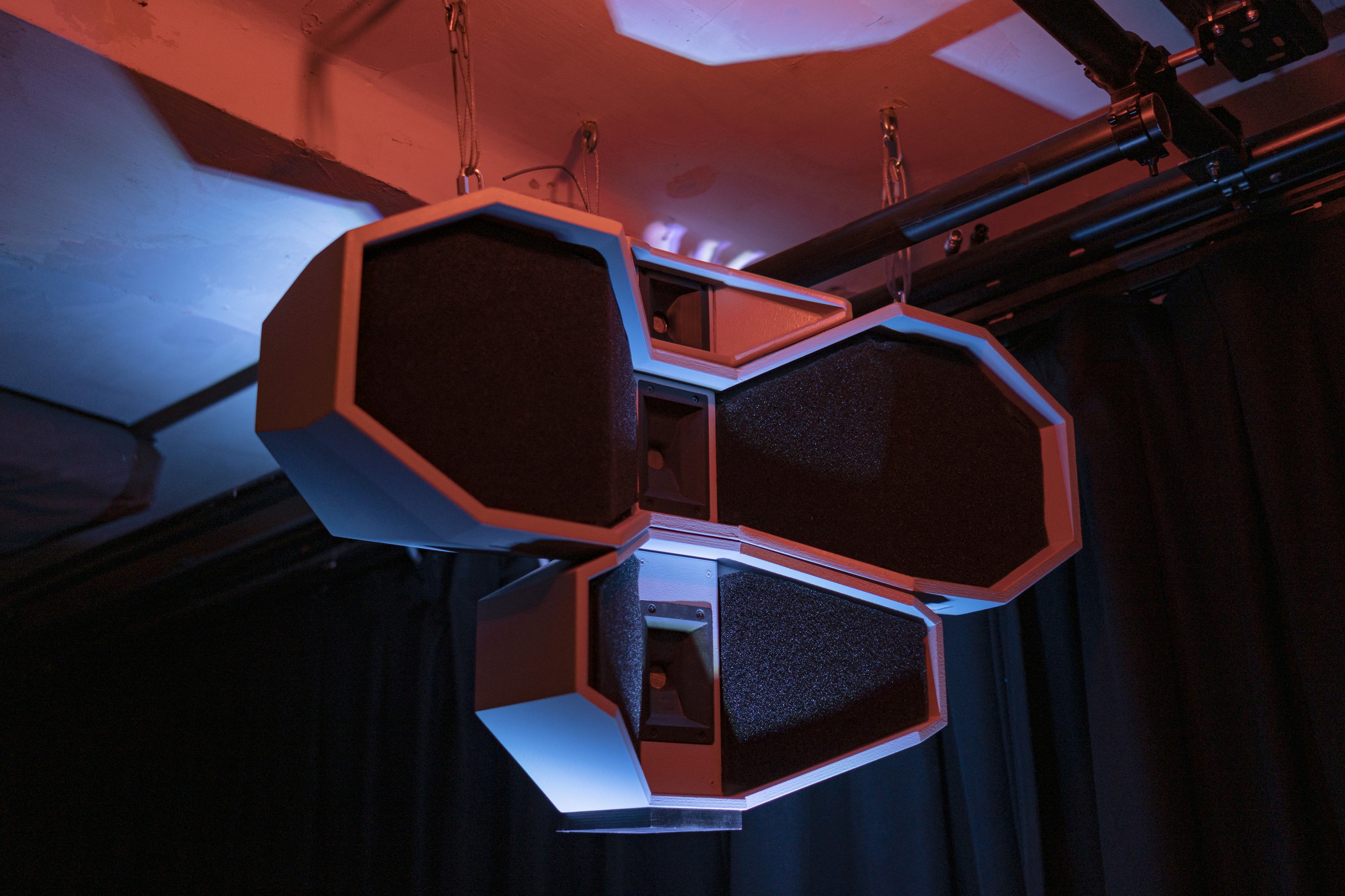EM GUIDE: Interview with Nº Space founders, Kristóf Huszár and Csaba Bognár

Nº Space is a venue and place for performing and listening to music, which opened its doors on September 6, 2024 on the first floor of Nyolcésfél, a cultural centre located in the 8th district of Budapest, Hungary. It was founded by Kristóf Huszár and Csaba Bognár, who were missing environments created for focused music listening from the Budapest scene, so they decided to open their own place.
I met Csaba and Kristóf on a September evening back in 2024 in Nº Space, and talked to them about the venue’s background, concept, the early days and of course, their long-term plans.
Let’s start with the name. Why did you choose this particular one, and is it pronounced “N Space”, or “No Space”?
Csaba Bognár: Nº comes from Numero, but simply, we’d like to express “No” with it. Nº Space, that is, No Space Left, meaning that there is no space left in Budapest, that’s why we created one. So it also expresses the very basic idea behind the venue itself.
In the beginning, we called the projekt “lehallgató”, and for location, Kristóf scouted Nyolcésfél (“lehallgató” in Hungarian both means “wiretapping” and “monitoring” in an audio studio – ed.). This “lehallgató” concept suited our ideas, especially since first we were checking out a room on the seventh floor, which was allegedly used for wiretapping during the communist era. In the end, we found that room not suitable for us, and we ended up on the first floor.
Kristóf Huszár: Along with that we came up with the idea of numbering our events, so we also started using Nº that way.
What is the concept behind Nº Space?
Cs.B.: In a sense, Nº Space is the evolution of Sepia Sound Studio, which we created with Péter Halász in AQB, based on his concepts. Back then, Péter worked as the manager at the now defunct SSI (Sepia Sound Institute, closely related to 4DSOUND), and I booked Yosi Horikawa there, that’s how we met. The concept of Sepia was to have a clear, immersive audio-visual workshop, but its mission was never accomplished. Péter joined me in planning and creating Nº Space, so I owe him a lot. I have known Kristóf for quite some time now, and we started this project together. We wanted to have an open space with a lot of room. Kristóf designed and worked both on the visual identity and the acoustic environment of Nº Space.
Right now we have a testing phase, we’d like to imagine Nº Space as a broad universe, and in the future we are open to include other branches, like a label, a zine, or a music-related community. In the meantime, there has been a change of operation at Nyolcésfél, that’s why we can be open only until 11:30PM, plus we have to face some additional costs; but as a studio and workshop, we can operate the way we want. Several things can change in the forthcoming months, both in a good and bad way, so we’re aware that we are at the beginning of a process.

So far I’ve only been to one event in Nº Space, and I saw that no drinks were allowed. Is this a part of your concept for the place, that not only you don’t have a bar, but you don’t even allow drinks for your events?
K.H.: We had events where drinks were actually allowed.
Cs.B.: We found it important that apart from the sound experience, nothing else should be in the room, not even a bar. Basically we envisioned an alcohol-free environment, but we don’t want to take this as a strict rule, it is absolutely possible to have events where it’s totally unnecessary to have limitations like that.
What is your vision with the place, what is it suitable for?
Cs.B.: Nº Space is a listening environment, an audiovisual workshop, rehearsal studio and space for performances. Besides that, it is also a place where we can be a part of a musically inspiring atmosphere, and you can develop your music in a club setting. The sound is pretty straight here, no coloring whatsoever, you can really hear what’s there.
K.H.: Of course, the space can also work for acoustic performances, but since both of us are coming from an electronic music background, when coming up with the core idea of Nº Space, the primary focus was on electronic music. (Besides his solo outlet, Kristóf is also a member of AGAVOID and KAIROS – ed.).
Cs. B.: We also hosted an UH Fest event, where Belgian guitarist, Venediktos Tempelboom, and Mexican sound artist, Angélica Castelló performed. But yeah, due to the size of the place, there are certain limitations regarding the number of people who can take the stage.
In October, Feral (Alessandro Barchitta, Italian DJ/producer – ed.) had a masterclass / music producing workshop. We could put chairs in there, we had two couches: so altogether we can provide 50 seats.
K.H.: Actually, this was our concept, to make the place as modular as possible: the objects here should be mobile, arrangeable. Even if, let’s say, the performer wants to be in the middle of the room, we can pull that off.
Are you planning any non-musical events here?
Cs.B.: We are open for that, but mainly, Nº Space aims to host music-related events.
What sound system do you have?
K.H.: The story goes like this: we started looking for sound systems, we talked to all of the Hungarian manufacturers and distributors, and we had a quite bad experience with them. We received bad offers, or offers with execution periods of like, 14 months.
Cs.B.: Moreover, we had the feeling that we are not taken seriously. For example, we talked to someone, agreed that he’ll come over to take a look at the space, then he didn’t care to actually come for several appointments. When he actually came to see the place after all, the following day he sent us an offer based on completely wrong parameters, for a totally unrelated concept. But we also contacted people who didn’t even care to reply.
K.H.: We had this going on for a while, all of our friends knew that we were on a mission to find a good sound system. One day, a friend of ours from Transylvania told us that there is this guy called Yamada, who has a workshop near Cluj-Napoca, where he’s building sound systems. He designed the sound architecture of Mumus festival in Transylvania, but I can also mention the Csodaszarvas stage at Kolorádó festival, which also uses Yamada’s system.
Cs.B.: His manufactory is called Kannonaudio, and before moving to Transylvania, he had already built quite a few clubs in Japan.
K.H.: We asked Yamada to give us something from his repertoire, but he said he would rather design something specifically for us. In one month he brought us a temporary system, so we would have something until the final solution is carried out. After a few months we indeed got the promised sound system, with the best price-value offer compared to other manufacturers by the way.
Since this is a custom-made sound system, we do not know yet, what its final form sounds like. Yamada and his crew told this too, that this is a continuously changing system that needs to be developed from time to time, a task they are happy to undertake. For example, the system’s quadraphonic potentials are not yet calibrated. And of course fixes, swapping its parts are in the plan: I’m not exaggerating when I say that the whole thing was declared ready 3 minutes before our opening night. But we are very much satisfied with Yamada’s work, we were convinced that he puts his heart and soul into all of this, driven by the “sound above everything” attitude. The point is to make it good, nothing else matters.
Cs.B.: Speaking of his character, it is really telling that once he was done working on the system, he sat down on the couch, and he was just listening to it for 4 or 5 hours.
K.H.: Yeah, Yamada was here on our opening night from the first act to the last, and he was listening to the sets. So he’s not the kind of guy who just delivers the stuff, and then just disappears with his money.

So far, all the events I’ve seen at Nº Space required registration. Why is that? Are you planning to keep this format in the future?
K.H.: We are not aiming for mass-events, but for performances, where everyone can have a good time, and the space won’t feel crowded. The reason we are planning to keep registrations is because over time, we’d like to leave all social media platforms, and it’d be so much better to communicate our events to our base, our audience over another channel, let’s say, via a newsletter.
Cs.B.: Moreover, basically we are a “box within a box”, referring now to Nyolcésfél, which is a circumstance we have to pay attention to. We cannot, and do not want to stress the infrastructure of Nyolcésfél. We are aware that the registration-format is not ideal – for free events, many people sign up, only to not show up in the end. But we had to come up with a form of control, because we did an opening night with no promotion, which received 2400 attendees on Facebook.
When describing yourselves, you use the terms sonic shelter and sophisticated listening environment. What vision do you wish to articulate with these terms?
Cs.B.: Fundamentally, we’d like to provide an experience here for both the listeners and the performers. I have had many bad experiences in the past, and since I’m making the kind of music I make (Csaba produces music as sabw – ed.), I very much felt at some point that I cannot perform this at any venue. When someone from the audience steps to me saying “don’t you have a more cheerful track?”, then it’s actually me who’s in the wrong place. With Kristóf we wanted to create a space that is actually a ‘no’ space – that is, not actually a space, but something, that it surrounded by sound. A sonic shelter.
K.H.: And our vision, as we see it, seems to be working. In all of our events so far when the audience arrived, they knew right away how to behave. They sat down, paid attention, and they all respected each other. What we had in mind, happened in real life.
Based on what you’ve said, you imagine Nº Space to be a venue where everyone present focuses on the music, or in other words, they are not talking. And for those who wish to have a more social, conversational experience, there is the backyard. Is this correct?
K.H.: Yes, and this is why this separation from the venue and the backyard works, because people need to cross the hallway for that. Following a performance, you go outside, get your drink, discuss what you’ve seen, then come back and listen to music again.
What does the event management look like at Nº Space?
K.H.: We’d like to run our own series too, but our main idea is to invite event planners to Nº Space. People who have a vision and capacity to carry out a whole night. We are looking for collaborations.
What is the feedback so far?
Cs.B.: Let’s start with the downsides, which are annoying, but not unsolvable things. We did not want to open during Summer because of the heat, so we had our opening event during the first week of September, but turns out that was still a pretty hot period. And our ventilation system crashed, which was a pretty hard pill to swallow, ‘cause we know how important that is, but yeah, the execution of that unit has been botched.
K.H.: Yes, we had technical difficulties before we opened. If we were to carry out the opening night now, the whole thing would look a lot different.
Cs.B.: Even the ceiling is not completely finished, that’ll get an acoustic covering too. It looks nice the way it does now, but we know that it will improve the sound.
I think that’s okay, and we can also say that these are just teething problems in the early phase. Confronting these will determine what’s next.
K.H.: We can only know what to improve if we get feedback.
Cs.B.: We explicitly asked our visitors and performers to let us know what their thoughts are on Nº Space. The sound quality was mentioned by everyone as a big pro. Someone also mentioned that as a performer it was so good to hear the same thing both on stage, and on the dancefloor. The sound is clear, but at the same time, it is loud enough to turn on an additional sense of yours.
K.H.: In Hungary, most venues focus on the loudness, and why’s that? Because of the alcohol. Consuming alcohol pushes down our senses, and that needs to be compensated. When you come to Nº Space, you will hear that surely, the music is loud – but it’s loud because it’s clear, so we don’t have to crank up the volume decibel-wise. Every club I went to in Europe, most venues actually don’t provide loud music. But if you go to a club in Budapest, the music is crazy loud, and it’s bouncing off the untreated walls. With Nº Space we wanted to provide a studio-experience, where you can hear even the tiniest details of the sound, that otherwise would go unnoticed even on your best sound system at home.
Cs.B.: By the way, the venues in Budapest have improved a lot in recent years, but the monitoring experience for the performers is still critical. In Nº Space, this works pretty good, and the performer can leave the stage thinking “finally, I could hear what I was playing”, and they receive the same impression as their audience. I think this is quite rare.

Did you have any examples or memories from other cities that inspired you for the concept and execution of Nº Space?
K.H.: Honestly, no. Maybe I can mention one example, the now defunct Noize Fabrik in Berlin, which was a venue, primarily used as a sound studio, and once in a while they hosted events too on the weekends. There you could also get the experience of a great sound system, where the music is not crazy loud, but people are having a good time, so it’s a proper party. Apart from that, I cannot mention any other examples.
So it’s difficult to mention specific sources of inspiration; instead we had strong ideas, what we didn’t want to achieve. We figured out many things along the way. Of course, we had an initial idea, but then we had to make compromises due to the limitations of the place, like the irregularities of the space that we had to treat acoustically.
What other developments do you have in the works?
K.H.: We mentioned this earlier, but yeah, executing and using the full potential of the venue’s quadraphonic capabilities is a big goal. We are already in talks with artists, who might be interested in that. Furthermore, we are planning to build a big 3-piece video projector system. With that, we can make screenings for the entire wall on the side of the venue.
So you can optimize the sound system, thus the whole listening experience for an audience that is facing these walls to the side?
K.H.: Naturally, the venue has a definite direction, but it’s also true that you can stand anywhere here, and you’d get almost the same experience. As we mentioned earlier, modularity is key. We put a lot of effort into making everything as flexible as possible.
Where can people find information about your upcoming events?
Cs.B.: We have social media platforms (Facebook, Instagram), but in the long run we’d like to switch to some subscription-based solution, like a newsletter.
K.H.: I’ve just read recently an article that describes the “death of the follower”, stating that this is actually happening – what comes next is still unclear even for the big players out there. Posting an event or anything, and then actually reaching your followers, which is something you could do 5 or 10 years ago, that just simply doesn’t work anymore. Let’s say you have 3000 followers, and you post something, then you get 50 likes for that; then surely, that’s absolutely not your fault. Furthermore, Facebook is getting less and less usable for managing events. Until recently, when someone invited me to an event, you saw it right away in the notifications section, what the event was about. A few months ago I noticed that this has changed: now you only see that “this person has invited you to an event”. And if I see 15 of these in my notifications menu, then am I supposed to click on all of them, to see what those events are about? Not ideal at all.

This article is brought to you by MMN as part of the EM GUIDE project – an initiative dedicated to empowering independent music magazines and strengthen the underground music scene in Europe. Read more about the project at emgui.de
Funded by the European Union. Views and opinions expressed are however those of the author(s) only and do not necessarily reflect those of the European Union or the European Education and Culture Executive Agency (EACEA). Neither the European Union nor EACEA can be held responsible for them.